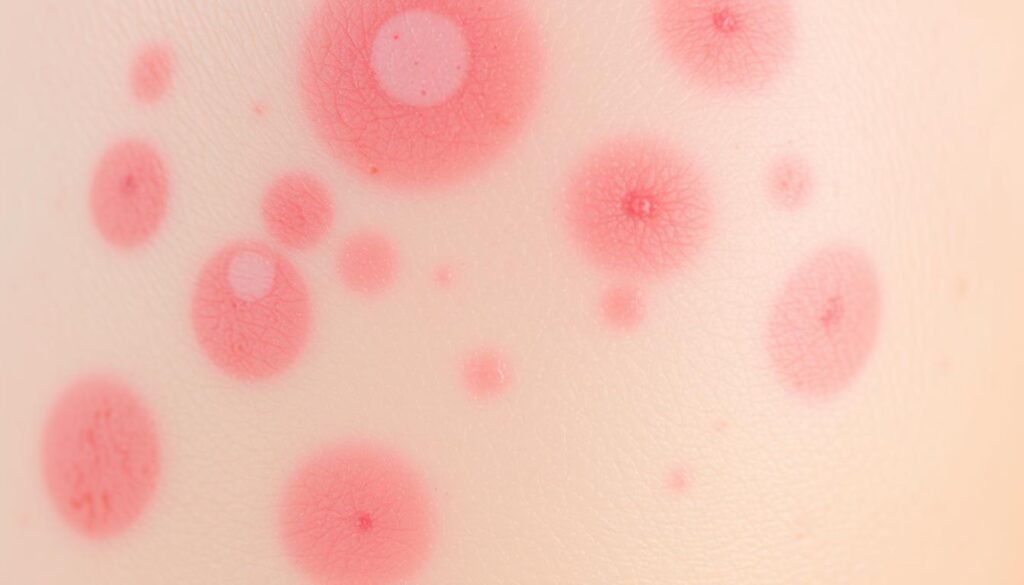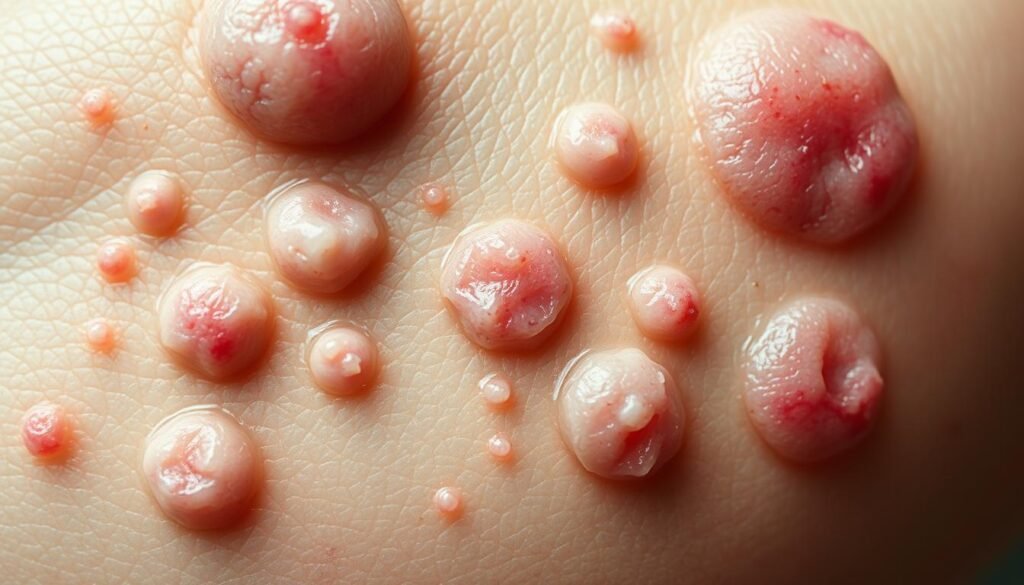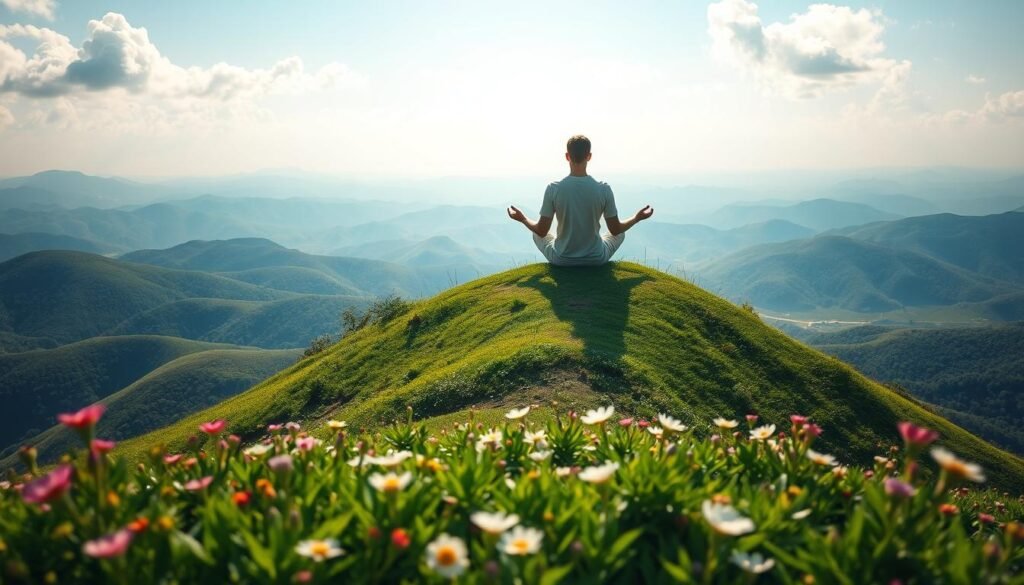Did you know stress can set off skin problems? About 20% of people will experience itchy rashes or hives at some point. Anxiety bumps, also called anxiety rashes, pop up due to emotional stress. These bumps can suddenly appear, making people feel uncomfortable and worried.
Knowing how anxiety affects your skin is key. It helps in managing symptoms and making your overall health better.
Key Takeaways
- Anxiety bumps can manifest as itchy rashes or hives due to stress.
- Symptoms of anxiety rashes generally resolve within 24 hours.
- Chronic anxiety increases the risk of developing skin conditions.
- Stress management techniques can significantly help alleviate symptoms.
- Understanding the triggers of anxiety is essential for prevention.
- Consulting a professional may be necessary for persistent cases.
What Are Anxiety Bumps?
Anxiety bumps are skin reactions caused by high stress or anxiety levels. They look like hives or rashes and can show up anywhere on the body. They’re different because they come from how we feel inside, not the environment.
Hives from anxiety can be big or small, from the size of a pencil tip to as large as a dinner plate. They can appear on your face, chest, neck, or arms.
These bumps often itch and make you uncomfortable, making you feel worse. Stress makes them pop up by causing your body to release chemicals. These chemicals increase inflammation and sensitivity.
If not taken care of, anxiety bumps can become a constant problem. It’s key to know why they happen and how they’re linked to our feelings. Finding the right treatment can ease the itch and discomfort they bring.
Symptoms of Anxiety Bumps
Anxiety bumps often show up as raised, red spots that can feel quite uncomfortable. They look a lot like an anxiety rash and make your skin itch. These spots can be small or big, and they pop up anywhere on your body. The neck, chest, arms, and face are where they’re found most.
These bumps come with several symptoms, including:
- Itchy, inflamed patches of skin
- Small bumps or papules that typically resolve within 24 hours
- Heightened feelings of irritability or restlessness
- Apprehension related to non-threatening situations
Stress reduction often leads to symptom improvement. This improvement can happen in a few days. However, as some bumps fade, new ones might appear. So, it’s important to know the difference between anxiety bumps and other skin issues to treat them right.
Understanding these symptoms helps us see how stress affects our bodies. Stress can make skin problems like psoriasis, eczema, or rosacea worse, leading to anxiety bumps. Being aware of these signs is crucial for dealing with itchy skin anxiety and finding relief.
| Symptom | Details |
|---|---|
| Raised Red Bumps | Itchy spots that may appear on various body parts. |
| Duration | Typically resolves within 24 hours with reduced stress. |
| Color | Ranging from red to pink, indicating inflammation. |
| Affected Areas | Commonly observed on neck, chest, arms, and face. |
Causes of Anxiety Bumps
The main reason for anxiety bumps is the body’s stress response. When people get stressed, their bodies release histamine. This causes inflammation and skin irritation. This reaction is a big part of how anxiety and skin issues start. Stress-induced bumps appear on the body because of it.
Many things can make anxiety worse and cause skin problems:
- Genetic predispositions: If your family has a history of anxiety or skin issues, you might be more likely to have them.
- Environmental stressors: Things like trauma, long-term sadness, or big life changes can make anxiety symptoms worse.
- Lifestyle choices: Eating poorly, not sleeping enough, and not exercising can all increase stress. This leads to more anxiety and skin reactions.
Hives from anxiety usually look like red spots on the face, chest, and arms. Issues like anxiety or depression can make things worse. It’s important to take care of both your mind and body. Chronic stress can not only cause stress-related bumps but also make conditions like acne worse.
To reduce anxiety bumps, managing stress is key. Cognitive-behavioral therapy helps many people find long-term relief from anxiety. Also, taking steps to prevent anxiety can lower the chance of skin problems. Knowing how mental and physical health are linked leads to better handling of anxiety bumps.
How Anxiety Triggers Skin Reactions
Anxiety causes skin issues through changes in the body, especially when stress increases. The body releases cortisol and histamine, making the skin more sensitive. This can lead to a stress rash, showing up as red bumps or welts. A 2016 study found these rashes can be mild or severe, depending on stress levels.
If stress lasts for a long time, the body might make too much oil. This can lead to acne or make skin conditions worse. Chronic stress can also cause itching, tingling, or a crawling feeling, often in the scalp or palms. Skin irritation anxiety and tight muscles can make these issues bigger. This shows how closely linked our mental health is to skin health.

To manage a stress rash, it’s important to treat both the skin and the stress causing it. Using cold compresses can quickly help with itching and redness. Over-the-counter antihistamines might also help. Techniques to reduce stress, like meditation and deep breathing, are key in dealing with the anxiety at the heart of these skin problems.
| Management Strategies | Benefits | Recommendations |
|---|---|---|
| Cold Compresses | Relieves itching and decreases redness | Apply for 15-20 minutes on affected areas |
| Oatmeal Baths | Soothes irritated skin | Use colloidal oatmeal preparations |
| Stress Reduction Techniques | Minimizes overall stress levels | Incorporate yoga or meditation into daily routine |
| Over-the-Counter Antihistamines | Alleviates itching and inflammation | Consider diphenhydramine or cetirizine |
Sometimes, anxiety rashes might be a sign of an allergy or a different skin condition. If a rash doesn’t go away in 24 hours or gets worse, seeing a doctor is a must. Working with both dermatologists and psychologists can lead to better treatment for skin and mental health. For more information, check out what anxiety rashes look like.
Understanding Anxiety Rashes and Hives
Anxiety rashes, often called anxiety hives or urticaria, show up as red, itchy spots on the skin. Around 20% of people will face these reactions during their life, says the American College of Allergy, Asthma and Immunology. These bumps can pop up anywhere, including on your face, neck, chest, and arms.
Stress can lead to skin issues like puffy red bumps that move around the body. One hive might go away, and then another appears. These symptoms can stick around for a day or up to several weeks. They usually get better on their own. But many folks find relief using oral antihistamines such as Benadryl and Zyrtec. If the rashes keep coming back, it’s a good idea to see a doctor.
Stress hives hit women and those assigned female at birth more often, especially in their 20s to 40s. If you’ve had allergies before, you might be more likely to get these stress-related skin problems. Working on stress is a big part of dealing with these rashes.
Knowing what triggers your stress can help avoid these rashes. Taking cool showers with unscented soap and wearing loose clothes can ease the itch. For more info on how stress affects your skin, check out this source.
| Characteristic | Description |
|---|---|
| Common Symptoms | Itchy, puffy red bumps on the skin |
| Duration | Can last from a day to several weeks, usually resolving on their own |
| Treatment | Oral antihistamines like Benadryl or Zyrtec |
| Common Areas Affected | Face, neck, chest, arms |
| Prevalence | Affects approximately 20% of individuals at some point |
| Gender Bias | More frequent in women and those assigned female at birth |
Recognizing Stress-Induced Bumps
Stress-induced bumps look like small, raised marks or red areas on the skin. They show how anxiety and skin problems are linked. This is important because intense worry or fear often causes these bumps.
Studies reveal that 20% of people might get hives because of stress. Noticing these bumps is the first step in dealing with them. Sometimes, they go away in a day but can last longer.
If a rash stays for more than six weeks, it’s considered chronic. You will need to see a doctor. Stress increases cortisol, leading to more oil on the skin and possible acne.
Stress can make skin problems like psoriasis and rosacea worse too. Identifying a stress rash is important. These rashes can hurt or itch and suddenly appear.
If a rash spreads over the body, has open sores, or gets infected, you must see a doctor. To ease the symptoms, try cold packs or antihistamines like Benadryl.
Knowing what stresses you can help manage your skin’s reactions. Try deep breathing, meditating, or writing in a journal. Talking about your stress with someone you trust can also make your skin better.

Overall, understanding stress bumps and their link to anxiety is key to your health. For more advice on handling anxiety and skin issues, check out this helpful resource.
Treatment Options for Anxiety Bumps
There are many ways to treat anxiety bumps. Using topical treatments and oral antihistamines helps a lot. People with these bumps often want fast relief to feel better and more confident.
Topical Treatments
Hydrocortisone creams can calm inflammation and stop the itching. They work by soothing the skin. You can easily find these creams at stores, helping those with stress-related skin problems.
Oral Antihistamines
Medicines like Benadryl and Claritin are great for anxiety bumps. They reduce hives and skin discomfort. Along with stress management, these drugs are key in treating anxiety bumps effectively.
Long-Term Management of Anxiety Bumps
Managing anxiety bumps over time means finding what works for you. You can try meditation, deep breathing, and staying active. These activities help cut down on stress. In turn, this reduces anxiety bumps on your skin.
Coping Techniques
Adding healthy habits can boost how you feel inside. You might try:
- Meditation.
- Mindfulness practices.
- Physical exercise like yoga or aerobics.
- Engaging in hobbies that are calming.
- Getting into a steady sleep pattern.
These habits help you stay calm. This might keep anxiety issues from getting worse. Skin-care routines also support managing anxiety bumps, according to Mayo Clinic’s advice on chronic hives.
Cognitive Behavioral Therapy
Cognitive Behavioral Therapy (CBT) is really effective for anxiety. It’s a focused approach that changes how you think and react to stress. CBT helps you swap bad thoughts for positive ones. Studies show it really helps with anxiety bumps by tackling the root of the anxiety.

CBT helps create solid coping skills. This means less anxiety overall. Getting help from a therapist makes your emotional health more stable. This can make anxiety bumps less common and severe.
| Coping Technique | Potential Benefits |
|---|---|
| Meditation | Reduces stress and promotes relaxation. |
| Deep Breathing | Lowers immediate feelings of anxiety. |
| Physical Activity | Boosts mood and enhances overall well-being. |
| CBT | Restructures negative thought patterns. |
Using these methods with therapy helps a lot in managing anxiety bumps. It makes the quality of life better.
Lifestyle Changes to Reduce Anxiety Bumps
Making changes in your lifestyle can help a lot with anxiety skin problems. Doing regular exercise boosts endorphins, your body’s happy chemicals. In 2023, about 33 million Americans did yoga, showing many are choosing holistic wellness. These activities reduce anxiety and make you healthier overall.
Eating a balanced diet with lots of fruits, veggies, and grains helps too. Foods rich in nutrients can make you feel more stable and energized. Also, getting enough sleep is crucial. But, over 70 million Americans struggle with sleep issues. And one in three adults isn’t sleeping enough, making skin problems worse.
Practicing mindfulness like meditation can also lower your anxiety. Nearly 14% of adults have tried it, which helps calm the mind and strengthens emotional health. Cutting down on alcohol and caffeine is also key in reducing anxiety skin flare-ups.
To wrap it up, changing your lifestyle in these ways can help both your mind and body. Look at this list of effective strategies:
| Strategy | Benefit |
|---|---|
| Regular Exercise | Enhances mood, reduces anxiety, and improves sleep quality |
| Mindfulness Practices | Reduces stress, promotes relaxation, and improves overall well-being |
| Balanced Diet | Stabilizes mood and energy levels |
| Quality Sleep | Decreases anxiety symptoms and improves skin health |
| Social Connections | Combat loneliness and enhance emotional support |
By making these lifestyle changes, you can fight anxiety bumps and feel better. Getting advice from experts can offer more help. For more tips on handling anxiety, check out this useful link.
The Psychological Impact of Anxiety Bumps
Anxiety bumps can deeply affect a person’s mind and feelings. Many feel very self-aware and embarrassed about their skin. This worry over how they look can make their anxiety and skin issues worse. When anxiety goes up, people pay more attention to their skin problems. This makes them feel even more stressed and upset.
Studies show that skin issues like anxiety bumps can make stress and anxiety worse. Many with skin problems say stress makes their condition worse. For example, those with atopic dermatitis and psoriasis often feel more anxious because of their skin. Handling these mental parts is key for better health.
The connection between mind troubles and skin issues is well-known. Issues like post-burn itch and chronic liver disease show how anxiety can hurt life quality. Those dealing with these problems often feel sad and scared. Using both mental and skin care treatments together helps a lot. This full-care approach works better for treating anxiety bumps.
| Skin Condition | Psychological Symptoms | Common Treatments |
|---|---|---|
| Atopic Dermatitis | High anxiety and stress levels | CBT, stress management |
| Psoriasis | Depression and anxiety | Medications, therapy |
| Chronic Idiopathic Urticaria | Emotional distress, anxiety | Antihistamines, CBT |
| Post-Burn Pruritus | State and trait anxiety | Therapies, mindfulness |
When to Seek Professional Help for Anxiety Bumps
Knowing when to get help for anxiety bumps is key. If these bumps last more than a few days or get worse, it’s time to act. Also, if you have trouble breathing, seek help right away from healthcare pros.
Talking to a healthcare worker can help you understand your anxiety better. Getting professional help can ease your symptoms. It also shows you how to manage them better. Getting help early can stop bigger problems later and make your life better.
Stress can show up in different physical ways, like high blood pressure or skin problems. Younger adults, especially women, often face anxiety disorders. This is more common in people from their 20s to 40s. So, it’s important to act early.
Here’s a brief overview of when professional help is advisable:
| Symptoms | Actions to Take |
|---|---|
| Persistent anxiety bumps | Consult a healthcare provider |
| Worsening skin reactions | Seek dermatological evaluation |
| Difficulty breathing | Immediate medical attention required |
| Accompanying severe symptoms (e.g., hives) | Visit a medical professional |
This approach helps you get the right care for both your mind and body. Spotting the signs early leads to better ways to handle stress. This can make you feel better overall.
Conclusion
It’s crucial for those dealing with anxiety bumps to manage them well. These skin issues from anxiety can really affect someone’s day and h
ealth overall. To ease the discomfort, one needs to know what these bumps are about. They should spot the signs early. Also, it helps to know the many ways to treat these symptoms. About 40 million Americans deal with anxiety disorders. Sadly, only 36.9% get help, says the Anxiety and Depression Association of America.
Tackling both the mind and body issues linked to anxiety is key. Using cognitive behavioral therapy, medicines, and changes in lifestyle can help. Activities like exercising and practicing mindfulness are beneficial. Anxiety can hit at any age, and fears can vary. But personalized coping methods can lead to big improvements.
K
nowing how stress affects skin health is the first step towards a better life. By looking after their mental health and using good strategies to cope, people can lower their chances of getting anxiety bumps. This promotes a healthy setting for overall well-being.